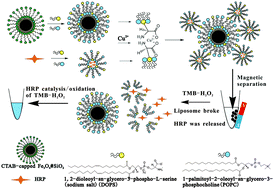Phosphatidylserine-functionalized Fe3O4@SiO2 nanoparticles combined with enzyme-encapsulated liposomes for the visual detection of Cu2+†
Abstract
We herein reported on novel phosphatidylserine-functionalized Fe3O4@SiO2 NPs (nanoparticles) and enzyme-encapsulated liposomes for the visual detection of Cu2+ by employing phosphatidylserine for Cu2+ recognition and the enzymatic catalysis/oxidation of 3,3′,5,5′-tetramethylbenzidine sulfate (TMB) as a signal generator. Phosphatidylserine (1,2-dioleoyl-sn-glycero-3-phospho-L-serine, DOPS) was covalently assembled on the Fe3O4@SiO2 NP surface to obtain DOPS-functionalized Fe3O4@SiO2 NPs, and was used to encapsulate horseradish peroxidase (HRP) to form HRP-encapsulated DOPS liposomes. It was demonstrated that DOPS-functionalized Fe3O4@SiO2 NPs can specifically bind HRP-encapsulated DOPS liposomes in the presence of Cu2+ at basic pH. The HRP-encapsulated DOPS liposome bound on the DOPS-functionalized Fe3O4@SiO2 NPs was then separated from solution with a magnet. Upon the addition of TMB–H2O2 solution, the HRP-encapsulated DOPS liposome bound on the DOPS-functionalized Fe3O4@SiO2 NPs was broken to release HRP, and the released HRP catalyzes the H2O2-mediated oxidation of TMB, which gives rise to a change from colourless to blue in solution colour and a new absorption peak at 652 nm. This provided a sensing platform for the sensitive, specific and field-portable colorimetric detection of Cu2+. By using the sensing platform, a selective and sensitive visual sensor for the detection of Cu2+ was developed. The proposed method has outstanding advantages including adequate sensitivity (the sensitivity can be improved by using a greater volume of the water sample), shorter analysis time, relatively low cost, operation at room temperature and stronger resistibility to the matrix. It can be used to detect as little as 0.1–0.5 μM of Cu2+ in river water using naked-eye observation and 0.05 μM of Cu2+ in river water using UV-visible spectrophotometry when 2 mL of the water sample was used for detection, within 15 min and with a recovery of 95–101% and a RSD < 5% (n = 5). A visual detection limit of 0.1–0.5 μM is much lower than the maximum allowable level of Cu2+ (∼20 μM) in drinking water defined by the USA EPA. The above features make our sensor a promising approach for the rapid and on-site detection of trace free copper ions in aqueous environments by only naked-eye observation.


 Please wait while we load your content...
Please wait while we load your content...